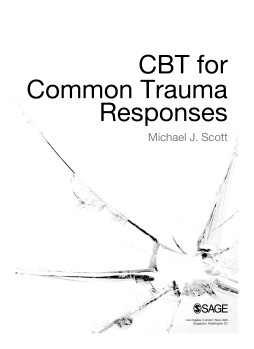
Additional Information
Book Details
Abstract
This is the first book to show how to use cognitive behavioural therapy (CBT) with the full spectrum of post-traumatic responses; exploring how they affect and relate to one another. Focusing not only on co-morbidity with other anxiety disorders and depression, the book looks more widely at, for example, co-existing pain, substance abuse and head injury.
After discussing how to tailor CBT practice to work most effectively with trauma responses in real-world settings, Michael J Scott goes on to explore the step-by-step treatment of post-traumatic stress disorder, other commonly occurring disorders and, finally, secondary traumatisation. Those training to work with young people, or already doing so, will find the focus in Part Three on CBT with traumatized children invaluable.
In terms of conceptualising the problem, the author is authoritative and thorough. There are questionnaires for assessing various types of condition as well as guided self-help material. I suspect many private practitioners will find this volume useful as a reference point, not least because of the information it provides about understanding and assessing trauma. My professional understanding was enriched by this book and it left me with new ideas for working with clients.
James Rye
Private Practice
I feel that this book is essential for all CBT practitioners and trainees working with traumatised clients. The author demonstrates how CBT works for real-world trauma clients. The excellent use of case studies makes this both accessible and readable and I value the clinically useful advice that the author gives for applying CBT to treat PTSD.
Adrian Pepper
'This book can be thoroughly recommended to those working with victims of trauma. Therapists will benefit enormously from the author's wide experience of the many varieties of trauma response and the conditions that frequently accompany them' -
Chris Brewin, Professor of Clinical Psychology, University College London
Table of Contents
| Section Title | Page | Action | Price |
|---|---|---|---|
| CONTENTS | iv | ||
| 1 POST-TRAUMA RESPONSES AND CBT – AN OVERVIEW | vi | ||
| Part One - POST-TRAUMATIC STRESS DISORDER | 8 | ||
| 2 A DSM V-BASED CBT MODEL OF PTSD | 10 | ||
| 3 ASSESSMENT AND ENGAGEMENT | 16 | ||
| 4 NON-TRAUMA-FOCUSED CBT | 25 | ||
| 5 TRAUMA-FOCUSED CBT | 37 | ||
| 6 GROUP TREATMENT | 55 | ||
| 7 DUAL TREATMENT OF PTSD WITH COMMONLY ASSOCIATED DISORDERS | 77 | ||
| Part Two - PRINCIPAL DISORDERS OTHER THAN PTSD | 96 | ||
| 8 SUB-SYNDROMAL PTSD AND PHOBIAS | 98 | ||
| 9 PROLONGED DURESS STRESS DISORDER | 105 | ||
| 10 CHRONIC ADJUSTMENT DISORDER | 109 | ||
| Part Three - SPECIAL POPULATIONS | 114 | ||
| 11 WORKING WITH TRAUMATISED CHILDREN | 116 | ||
| 12 WORKING WITH TRAUMATISED CLIENTS WITH A SEVERE MENTAL ILLNESS | 128 | ||
| Part Four - SECONDARY TRAUMATISATION | 136 | ||
| 13 THE CBT TREATMENT OF PAIN AND DISABILITY | 138 | ||
| 14 THE CBT TREATMENT OF HEAD INJURY | 158 | ||
| 15 THE CBT TREATMENT OF DISFIGUREMENT | 178 | ||
| Appendix | 197 | ||
| REFERENCES | 252 | ||
| INDEX | 260 |
